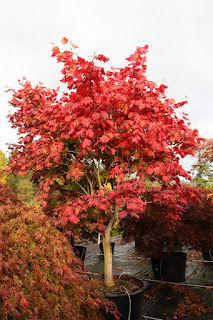Planting a Spectacular Weeping Japanese Maple for a Breathtaking Spring Display
Weeping Japanese Maples
Spring is the perfect time to plant a weeping Japanese maple, a gorgeous tree known for its cascading branches and delicate foliage. These spectacular trees come in a variety of colors and sizes, and can be used in a number of different garden settings to create an unforgettable display. Whether you're a seasoned gardener or a beginner, planting a weeping Japanese maple is an easy way to add beauty and elegance to your outdoor space. In this post, we'll cover everything you need to know to successfully plant and care for a weeping Japanese maple, including soil conditions, watering needs, and pruning techniques.
1. Choosing a Location
The first step in planting a weeping Japanese maple is to choose the perfect spot for it in your garden. These trees do best in partially shaded areas with well-drained soil. It's important to avoid areas that are exposed to strong winds or harsh sunlight, as this can damage the delicate foliage. A good spot is one that's protected from direct sunlight for most of the day, but still gets some dappled light. This will help your tree thrive and produce a beautiful display of leaves.
2. Preparing the Soil
Once you've chosen a location, it's time to prepare the soil for planting. Weeping Japanese maples prefer soil that's slightly acidic and well-drained. If your soil is too alkaline, you can add sulfur to lower the pH. It's also a good idea to amend the soil with organic matter like compost or aged manure, which will help improve the soil's texture and increase nutrient levels. Before planting, make sure the soil is loosened to a depth of at least 12 inches, to allow the roots to spread and grow easily.
3. Planting the Tree
Once the soil is prepared, it's time to plant your weeping Japanese maple. Dig a hole that's slightly larger than the root ball, and position the tree so that the crown is level with the surrounding soil. Fill in the hole with soil, tamping it down lightly to remove any air pockets. Water the tree thoroughly after planting to help settle the soil and hydrate the roots.
4. Watering and Fertilizing
Weeping Japanese maples need regular watering to keep the soil moist and the roots hydrated. During the first growing season, be sure to water your tree deeply every week or so, to help establish a strong root system. After the first year, you can reduce the frequency of watering to once or twice a month, depending on your climate. Fertilizing is also important to keep your tree healthy and vibrant. Use a slow-release fertilizer in the spring and summer, following the package instructions for the appropriate amount to use.

5. Pruning and Maintenance
Pruning is an important part of caring for a weeping Japanese maple, as it helps keep the tree healthy and looking its best. The best time to prune is in late winter or early spring, before new growth begins. Trim away any dead or damaged branches, and thin out any crowded areas. If your tree is getting too large, you can also prune back some of the branches to control its size and shape. Be sure to use a sharp, clean pair of pruning shears to avoid damaging the tree.
Conclusion:
Planting a weeping Japanese maple is a great way to add beauty and sophistication to your garden. With a little bit of planning and care, you can enjoy a breathtaking display of cascading foliage every spring. Whether you're a seasoned gardener or just starting out, we hope this post has helped you understand the basics of planting and caring for a weeping Japanese maple. Try incorporating one of these stunning trees into your garden this season, and discover the joy of watching it grow and flourish over time!




Comments
Post a Comment